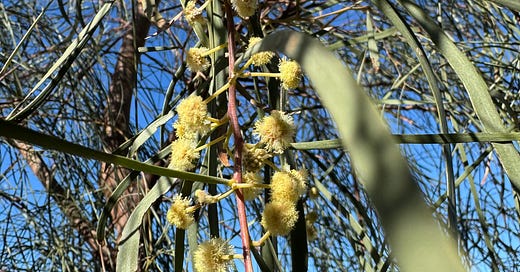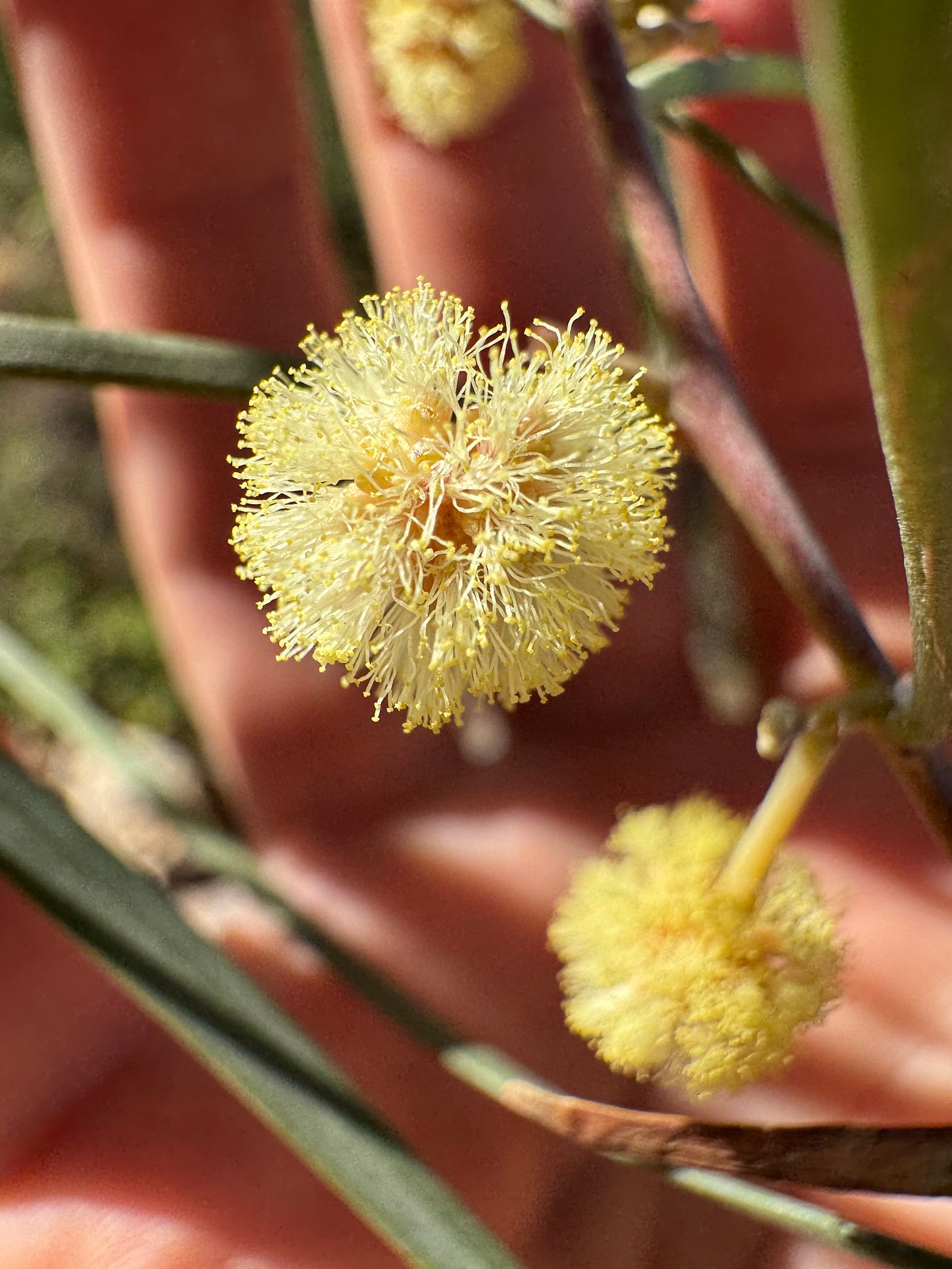A Closer Look at a Very Common Tree
Shoestring acacia, Acacia stenophylla, may be planted to excess in Las Vegas, but it is a lovely, useful tree. If you choose this tree for your garden, plant a five-gallon size or smaller.
Shoestring acacia (Acacia stenophylla) are common trees in our desert gardens. In fact, they have become so common that they now suffer from the horticultural problem of being over planted. They are inexpensive, quick growing, and beautiful trees, lining shopping malls and parking strips and the narrow corridor gravel gardens that lie between tightly sandwiched houses.
But this tree succeeds so well and looks so at home in the eastern Mojave desert that I understand why so many gardeners choose it. I planted one in my garden the first winter we moved to Las Vegas.
It grows near a backyard patio that abuts the primary bedroom and the French doors that exit into the back part of the garden. I planted it there to increase the privacy of this little brick patio that is mostly overshadowed by the neighbor’s second story balcony. The tree I planted was a little whip that flopped over the second I removed the stake that had been attached to the tree and driven into the small, five-gallon pot I purchased it in. It took a year for it to right itself, and now, just three years later, it is already established, looking a good 18 feet tall, with fine, wispy petioles, quasi-leaves, many about a foot long. In a pinch, the leaves could be used as laces, maybe even as a weaving medium.
In it’s historically native range in inland and arid Australia, it was used by indigenous folks in much the same way that mesquite trees (Prosopis spp) were used by indigenous communities in the southwest United States. It is a protein-packed legume. The pods can be roasted and eaten or ground into flour. The tree’s wood, which is hard and fast growing, was used to make fires or to make tools, like boomerangs. It is used all over the world to make hardwood floors. It is a tree made for people. And people all over the world in arid climates like the Mojave have taken to it.
Though I don’t come across many people consuming this tree, its abundance here in Las Vegas makes me think that it could be very useful during prolonged drought or any other Chaco-type extinction event. We’re unwittingly growing the tree that could stave off hunger if things ever got really bad. It also contains compounds that, in lab mice, have been shown to protect against the advances of Alzheimer’s disease.
But mostly in Las Vegas it is grown for its shape and form. Many trees native to this region of the world grow sprawling, wide crowns that are unsuited to the smaller, manicured yards most of our houses are sited on. Shoestring acacia is one of few trees that grows mostly up. In fact, it can be planted almost right on a property line without having to worry about branches straying too far into your neighbor’s property, where they will be violently hacked at to make way for a fifth wheel. Instead, they offer covetous dappled shade, so almost anything will grow well underneath them. And they are graceful, providing the near equivalent look of a weeping willow without all the water Salix species require.
They are, to be sure, a waterway tree. Almost all desert trees are. They benefit from deep, infrequent water—more often when they are young and establishing in the garden. But after a few years, water can be almost completely withheld, except during the hottest times of the year when they will appreciate a deep soak. Even that can be unnecessary if they are under-planted with cactus, flowering perennials, and dryland-adapted shrubs. The water these other plants get is likely sufficient for the wandering roots of the shoestring acacia.
Shoestring acacia are also excellent nitrogen fixers, which means their roots cultivate bacteria that take nitrogen from the air and deposit it into the soil, where nearby plants will appreciate the extra nutrition. For this reason, they are excellent nurse trees and would do well as the centerpiece in a hugelkultur bed, offering support to other desert edibles you may be interested in growing.
Like many Australian plants, they bloom in winter. Little yellow puff balls form along draping branches. While the little flowers are laden with pollen, I have not seen them visited by pollinators. But I am a poor observer and it is possible I have missed them. I have seen black flies sunning on the bark of the tree, which is reddish brown when young, a perfect foil to the olive green leaves. The flowers form long, string-like pods, that, when rattled, are among the most pleasant sounds in the southwest landscape, like little rain sticks, even if the rain they promise is something of a lie.
But if it is rain you are missing, stand near an acacia and you will certainly smell it. The young branches smell of petrichor (a term that also hails from Australia). I might add Acacia stenophylla to a short list of trees—a list that includes ponderosa, Pinus ponderosa, the bark of which smells like butterscotch—that are worth walking up to and burying your nose into for an olfactory delicacy.
Nurseries and even some famous horticulturists recommend this tree as a poolside planting because it is light on litter. I’m not certain they have grown this tree long enough, because the leaves, branches, and pods fall often and everywhere, but certainly less than the Mexican birds-of-paradise, Caesalpinia mexicana, that line my own pool.
I often see large specimens planted in landscapes, but this is an unequivocal waste of money. In just three years a slender pole of a tree in a five-gallon nursery pot will outgrow the large specimen, looking in a very short time like it has always been in your garden. This is a tree that requires almost no patience to achieve shade in summer.








I need this “covetous dappled shade” plant for my backyard. The neighbors behind us are in a three story home. We have no privacy.
I didn’t know they grew so fast. The three I planted this year will be big in no time. That’s exciting.